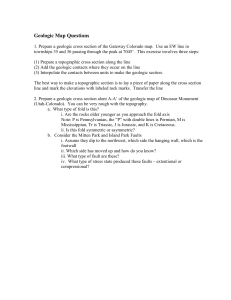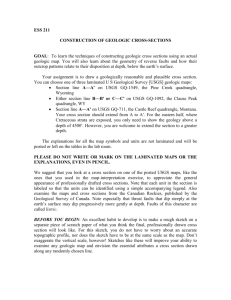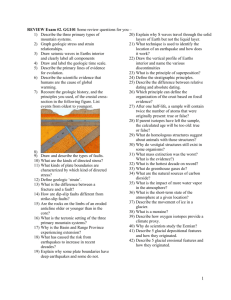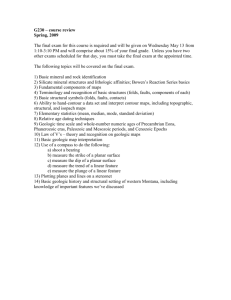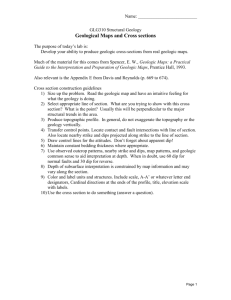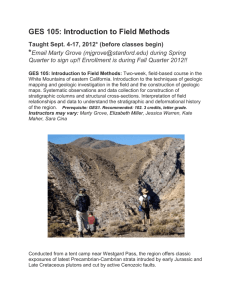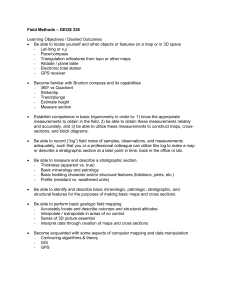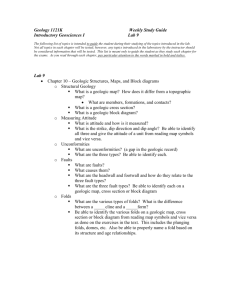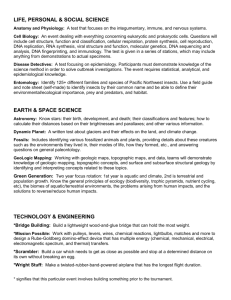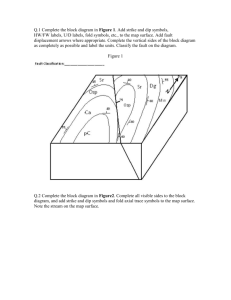Lab 4: Introduction to crosssections 1 Fall 2005
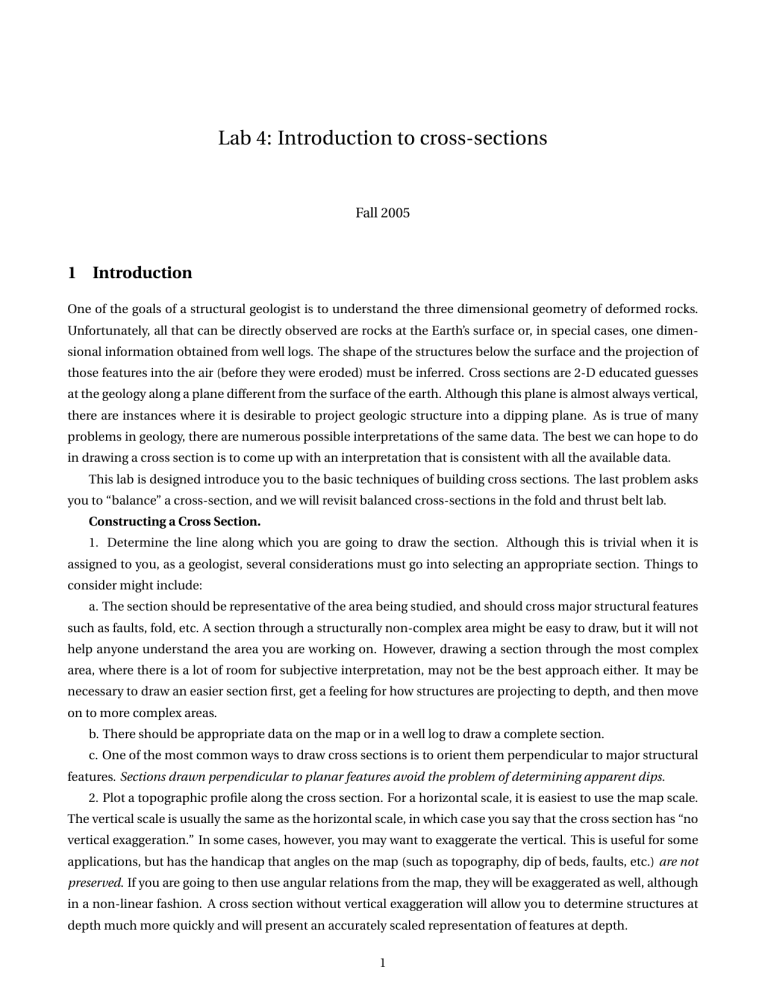
Lab 4: Introduction to crosssections
Fall 2005
1 Introduction
One of the goals of a structural geologist is to understand the three dimensional geometry of deformed rocks.
Unfortunately, all that can be directly observed are rocks at the Earth’s surface or, in special cases, one dimen sional information obtained from well logs.
The shape of the structures below the surface and the projection of those features into the air (before they were eroded) must be inferred.
Cross sections are 2D educated guesses at the geology along a plane different from the surface of the earth.
Although this plane is almost always vertical, there are instances where it is desirable to project geologic structure into a dipping plane.
As is true of many problems in geology, there are numerous possible interpretations of the same data.
The best we can hope to do in drawing a cross section is to come up with an interpretation that is consistent with all the available data.
This lab is designed introduce you to the basic techniques of building cross sections.
The last problem asks you to “balance” a crosssection, and we will revisit balanced crosssections in the fold and thrust belt lab.
Constructing a Cross Section.
1.
Determine the line along which you are going to draw the section.
Although this is trivial when it is assigned to you, as a geologist, several considerations must go into selecting an appropriate section.
Things to consider might include: a.
The section should be representative of the area being studied, and should cross major structural features such as faults, fold, etc.
A section through a structurally noncomplex area might be easy to draw, but it will not help anyone understand the area you are working on.
However, drawing a section through the most complex area, where there is a lot of room for subjective interpretation, may not be the best approach either.
It may be necessary to draw an easier section first, get a feeling for how structures are projecting to depth, and then move on to more complex areas.
b.
There should be appropriate data on the map or in a well log to draw a complete section.
c.
One of the most common ways to draw cross sections is to orient them perpendicular to major structural features.
Sections drawn perpendicular to planar features avoid the problem of determining apparent dips.
2.
Plot a topographic profile along the cross section.
For a horizontal scale, it is easiest to use the map scale.
The vertical scale is usually the same as the horizontal scale, in which case you say that the cross section has “no vertical exaggeration.” In some cases, however, you may want to exaggerate the vertical.
This is useful for some applications, but has the handicap that angles on the map (such as topography, dip of beds, faults, etc.) are not preserved .
If you are going to then use angular relations from the map, they will be exaggerated as well, although in a nonlinear fashion.
A cross section without vertical exaggeration will allow you to determine structures at depth much more quickly and will present an accurately scaled representation of features at depth.
1
3.
Mark contacts on the topographic profile where the particular feature crosses the line of the section.
Project dip data onto the line of the cross section and then to the topographic profile.
Projections can usually be made from several km distance, depending on the scale of heterogeneity of the structures.
There is no good rule for how far dips may be projected, but as long as you feel that there is no good reason for a dip to change between its location and the line of cross section, it may be projected.
If the dip does not project perpendicularly into the line (if the strike is not perpendicular), you must determine the apparent dip of the feature.
You can use the methods we developed in Lab 2 or you can use the handy chart provided with this lab.
4.
Draw in structures (faults, folds) and the lithologic units on the cross section so that unit thicknesses are preserved (in other words, constant) and the cross section units are consistent with the observed dips.
Dips of features that are not marked on the map may be determined with the three point method.
Note that the thickness of beds will be constant only across fold/faults if the cross section is oriented perpendicular to the beds.
If the section is not perpendicular to the beds, then the same unit may have different cross sectional thickness depending on the angle between the strike of the unit and the direction of the cross section (again back to Lab 2).
5.
Extend structures and lithologic units above the present level of erosion and to depth, if sufficient informa tion is present to do so.
This is the most subjective part of the process and multiple interpretations are possible.
You may want to complete several alternative cross sections.
The most important thing to keep in mind is that your cross section should be geologically, geometrically and physically reasonable.
6.
Finally, finish the cross section by drawing in the traces of the axial surfaces of anticlines and synclines, measuring offsets across the faults, and determining the stratigraphic thicknesses of the units.
Usually its best to do this last step by measuring on the map perpendicular to the strike in a structurally uncomplex area, where dips are relatively constant and proceeding as we did in Lab 2.
Coloring the cross section is also a good idea.
1.1
Balanced crosssections.
With enough imagination, any number of crosssections could be dreamed up.
A test of the reasonableness of a crosssection is whether it is balanced .
A balanced cross section must be both admissible and retrodeformable .
Admissible just means that the structures are reasonable given the geological setting of the rocks.
A section is retrodeformable if when all of the shortening by faults and folds is removed, the layers restore to a reasonable predeformation configuration with no significant gaps.
A fundamental assumption of balancing a cross section is that rock volume is conserved, and deformation is plane strain only – that is, there is no movement of material in and out of the section.
If units are of constant thickness, then bed length is proportional to area.
If this condition is met, then bed length for all of the units
(hanging wall length plus footwall length) will be equal.
There’s a little room for error: 510% is acceptable.
In order to undeform the cross section you need to establish a pin line which serves as a marker from which bed lengths are measured.
It must be in an area with no interbed slip and beyond the zone of deformation, usually in the undeformed foreland.
The amount of shortening can be determined by measuring the total horizontal length of a section in its deformed and undeformed states.
shortening (%) = [(ld lu)/lu]*100 ld = length deformed, lu = length undeformed
2
1.2
Summary of Balanced Cross Section Method:
1.
Compile geologic maps and subsurface data.
2.
Draw a section line parallel to the direction of tectonic transport (perpendicular to major structures).
3.
Ink in the topographic surface and geologic data.
4.
Project in well data and down plunge geologic data.
5.
Draw a separate restored stratigraphic layercake or wedge using the youngest preorogenic unit as a hori zontal datum (i.e.
compile your stratigraphic section).
6.
Find the depth to basement and draw in the basement surface on the deformed section.
7.
Lightly pencil in the thicknesses of stratigraphic units above the basement to give a guide for the depths of thrust sheets’ trailing edges.
8.
Draw a foreland pin line in the deformed section to correspond to the foreland edge of the restored section.
9.
Continue surface geology to depth based on axial plane intersections, depth to detachment calculations, or stratigraphic separation diagrams.
Have the trailing edge of each major sheet return to regional above the basement.
10.
Fill deep holes with imbricates, horses or duplexes as seems appropriate (highly speculative, well log data helps).
11.
Given hanging wall cutoff geometries on the surface or as reconstructed from unfolding kinks, draw subsurface footwall geometries to match.
12.
Measure bed lengths from the foreland pin point back through the section for each horizon.
13.
Measure off the same bed lengths from the foreland margin of the restored stratigraphic wedge.
This locates all faults in the restored section.
14.
Check that all local pin lines or wellconstrained surface geometries are preserved in the restored section.
15.
Check that respective hanging wall and footwall cutoffs match.
No gaps or overlaps in the restored section are permitted.
16.
Measure the area of each thrust sheet in the deformed and restored sections.
They should be equal.
If thrust sheets are not equal, find out where your stratigraphic thicknesses are wrong.
18.
When thrust sheet areas are equal, measure formation or other subunit areas in the deformed and re stored sections.
They should be equal.
19.
Expect that deep structures will need to be area balanced because bed length details will probably be incomplete.
20.
Color and display!
3
2 LAB 4 EXERCISES:
1.
a.
A line of section (XX’) is shown on the topographic map in Figure 1 and a space is provided at the side for the section.
Construct the topographic profile.
Put the base of the section at an elevation of 500 ft, and make the vertical and horizontal scales equal and the same as the map scale.
b.
The top surface of a limestone bed crops out at A.
The bed strikes due east and dips uniformly 10 degrees north.
Using a protractor draw the traces of the top of the bed on the section and then construct it on the map.
c.
In a similar fashion, construct the bottom contact, which crops out at B on both map and cross section.
Color the outcrop area of the limestone.
d.
A thin dike dipping 75 degrees due south is exposed at D.
Plot it on the cross section and construct its trace on the map.
2.
a.
Lay out a north to south line of section the length of the map in Figure 2 and construct the corresponding geologic section in the space provided.
b.
Complete the geologic map by adding the missing dip angle to the strike and dip symbols, drawing the fold axes, and indicating with appropriate symbols the relative displacement on the fault.
c.
Insert a table below the map listing the eight formations in order from youngest to oldest and giving their thicknesses in feet.
3.
Geologists almost always draw cross sections from maps and not the reverse.
Here, you will create a map on the basis of a cross section in this question.
A topographic map and geologic section of an area are given in
Figure 3.
The symbols have the following meanings: gr = granite, db = diabase, ss = sandstone, sh = shale, and ls
= limestone.
All contacts strike eastwest, so that the geology is the same in any northsouth section.
Transfer the geology from the section to the map.
Include the necessary structure symbols, namely fold axes, movement symbols on faults, and eight strike and dip symbols placed where they would be most useful if the problem were the reverse one of constructing the cross section from the map.
2.1
Balanced sections.
4.
Examine the crosssection in figure 4.
Does it balance?
Why or why not?
5.
Use the linelength technique to restore the crosssection in figure 5, and evaluate whether or not it bal ances.
If it does not balance, state specifically what is wrong with the section.
4
5
Figure 1:
6
Figure 2:
7
Figure 3:
8
Figure 4:
9
Figure 5:
